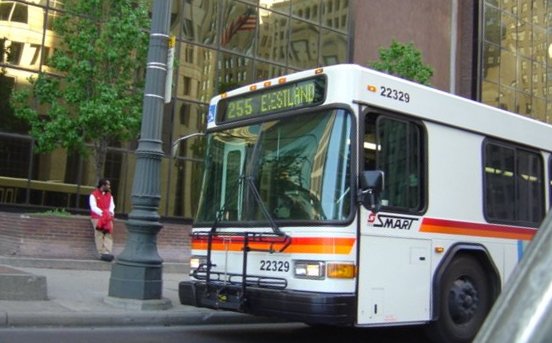Planning Conference Day 2: Downtown Traverse, Renewable Energy
We returned to Grand Traverse Resort for the second day of Planning Michigan, the Michigan Association of Planning annual conference.
One morning session I attended talked about the siting of renewable energy projects. The presenter was talking exclusively about wind sites and utility-scale photovoltaics. Depending on how you look at it, Michigan achieving a 100% renewable portfolio will require, variously, tens of thousands of acres of farmland to be converted to solar, or some mixture of that with wind turbines. Fortunately, wind turbines of today are far more efficient and can generate far more power than the wind turbines of yesteryear, so there’s at least that!
Remember this article? In it, I pointed out that the question of whether utility-scale solar is a good or bad use of potentially productive agricultural land is far less relevant than the fact that the market supports photovoltaic development of this variety. If you don’t like it, how about changing the regulatory landscape to encourage smaller-scale projects, namely rooftop solar?

NREL, for example, estimates that 39% of our total electricity demand could be provided by rooftop solar. This means that there would be no need for utility-scale solar farms. No community meetings where residents point their fingers at municipal planners and say things like, “I hope your wife dies of cancer!” (This was, according to our presenter, a real life statement uttered by a resident, angry at a proposed wind farm project– because, as we know from Donald J. Trump, windmills give you cancer).
So, why isn’t rooftop solar more popular? Why suddenly this focus on utility-scale PV, and zero discussion of smaller-scale? In a regulatory landscape that must evolve, and in which planners can play an active role by asking the right questions about how to facilitate more sustainable solutions, I asked about this, and our presenter was basically like, “Yeah, I don’t know anything about that.”
Which is, well, bizarre.
But anyway.
Of course, I know the answer, so maybe it was unfair for me to ask in the first place.
In many jurisdictions, utilities write the utility regulations. We see this in Michigan, where utilities spent millions of dollars lobbying legislators to eliminate net metering, allowing them to pay pocket change for excess power generated by DERs like rooftop solar. In a civilized jurisdiction, utilities have to buy the excess power back from the customer at the retail rate at which it’s sold to the customer. If the state gets involved in subsidies, it’s possible to provide a feed-in tariff (FIT) to actually pay the customers more money directly. This is a boon for people who install solar panels on their roof, and it’s even possible to use things like community solar (which, simplifying a bit, relies on pooled space and resources) to avoid the equity pitfall of having an FIT only benefit wealthy property owners.
I did manage to make a couple of connections with folks who were interested in talking about this, including University of Michigan’s Sarah Mills, who spoke with me after the session about some of the ways that regulation is evolving. I’ll say what I said in my other article: It’s less a question of whether solar development on open greenfield land is good or bad, and it’s more that the regulatory environment and energy markets encourage (or don’t discourage, certainly) this style of development.
Distributed generation is going to take years to figure out. But we need to start talking about it. And I’m glad some people are!

Afternoon: A Downtown With Parking Minimums– But Height Restrictions?
I stepped out for a tour of downtown Traverse City, hosted by CEO of the Downtown Development Authority, Jean Derenzy. We walked a loop around several blocks of the city’s downtown, looking at buildings and parking lots old and new. Of note was the fact that the city has, impressively, eliminated parking minimums for development! Hurrah, right?! It gets weirder still: a citizens group (which our speaker from yesterday might define as CAVE people, or Citizens Against Virtually Everything), successfully lobbied to create an ordinance that requires that all building projects in the downtown proposed to be over 60′ in height be put to a public vote.
Yes, you read that correctly! Developers can’t build on land they own, even if they have the appropriate zoning classification, if the height is more than 60′– unless they put it to a public vote. Derenzy noted that two projects have been quashed in this manner.
Like the lack of interest in smaller-scale solar development, this is also bizarre. But not shocking in the age of Trumpism.
Back onto the bus to return to Grand Traverse Resort, Jean Derenzy gave us each a $5 voucher in downtown Traverse bucks, which we can spend at any of a number of businesses in the downtown. My hometown had a similar program, and I think it’s a great way to incentivize spending at local businesses in an age when we are still talking about how to support small businesses against the Amazons and Wal-Marts of the world. Certainly, if I were trying to pick between downtowns, Traverse City would win out for the lack of parking minimums. The height restriction? Weird, but you can get quite a bit of density with four stories at under 60′. And it’s always great to have a dedicated community of professionals working to support those local businesses!
Follow along for more coverage of the Michigan planning conference. Or, read this piece about the first day!



